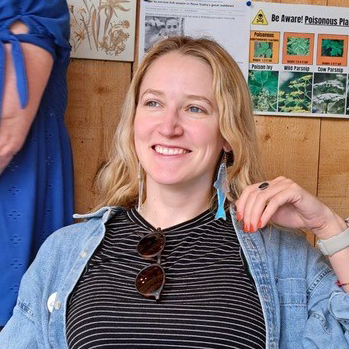Zoe Compton
Master of Arts (MA)
Art Education
Zoe Compton is a multi-disciplinary artist with dual interest in the arts and sciences. Her bachelor’s degree in fine arts and environmental studies along with her master’s in art education has set her up well for her current interdisciplinary work in science diplomacy at the Canadian Commission for UNESCO. Zoe comes from settler ancestry and is currently living in Montreal/Tiohtià:ke/Mooniyang.
Question 1: Tell me about yourself. Who are you?
My name Zoe Compton and I'm the Natural Sciences Programme Officer at the Canadian Commission for UNESCO (CCUNESCO). UNESCO is the UN Education, Scientific, and Cultural Organization and it is a specialized agency of the UN mandated to promote global peace through international cooperation in education, science, and culture. The Canadian Commission promotes UNESCO’s values and priorities to the Canadian government while making sure that Canadians have a voice on the international stage.
I moved from downtown Toronto to the Eastern Townships of Quebec after high school and that's where I really developed a passion for the environment and specifically, the forests there. I'm also a multidisciplinary artist. I like drawing, painting, and textile arts. I took up tapestry weaving during my master’s degree when I was looking for a more environmentally friendly art practice. From there, I enrolled in Bishop’s University in the Environmental Studies and Geography program and decided to do a double major with Fine Arts. I struggled to bring these two parts of my life together until I discovered the Art Education program at Concordia.
Question 2: What are you doing right now? How does your present work relate to art and art education?
Now I work in science diplomacy, which to me means advocating for Canadian perspectives on the international stage on matters related to UNESCO’s programs. For example, gender equality in sciences – globally, women represent only about 30% of people in science. Another priority in Canada is to ensure the full implementation of the UN Declaration on the Rights of Indigenous Peoples for Truth and Reconciliation. With regards to the future state of the world, we are also strong advocates for youth leadership and empowering the next generation of changemakers.
While it doesn’t sound related to art and art education, it’s a job that is very interdisciplinary and requires skills in communication, which the arts have helped me with. Today, I make art only for personal pleasure and honestly, I rarely have time. But I know it’s always there and I come back to it when I can.
Question 3: How did Concordia’s ARTE program prepare you for what you are presently doing?
The Art Ed program helped me to marry a lot of things in arts and sciences. Through an arts-based thesis, I explored my position as a settler in Canada, the environmental impacts from settler colonialism, and how the arts can be used to engage the public in these discussions. I researched my ancestors who first settled in Canada why they came here and their impact on the old growth forests of Prince Edward Island. I wanted to know learn about the Mi’kmaq, their perspectives, and their relationships to the land. From there, I made cartographic tapestries of the land where my ancestors settled from Google Earth images of today and of what I imagined it to be pre-colonization. I thought if I made something visually stimulating, it would invite more people to reflect on these complex things and make conversations around colonization more approachable; and encourage other non-Indigenous people to have similar reflections.
I find that many who study in sciences are limited to a narrow scientific research perspective. The Art Ed program really gave me a broader perspective on interdisciplinary work. At CCUNESCO, even though I'm the natural sciences officer, I work a lot with the culture sector and with the education sector. It’s also worth noting that CCUNESCO is housed within the Canada Council for the Arts, which in terms of bringing the arts into science diplomacy, it’s a unique organizational opportunity that I’m starting to explore.
Question 4: Describe one of your positive formative experiences while you were in the program at Concordia.
Thanks to great professors, the Art Ed program opened a lot of career doors for me. Through a teaching assistantship in the Community Art Ed program, I was hired at the Visual Arts Centre, which then led to a job at the PHI Foundation for Contemporary Art. At the same time, another professor who holds a UNESCO Chair, hired me on a grant to work with the Canadian Commission for UNESCO supporting the UNESCO Chairs network in Canada. It’s no doubt entirely thanks to these professors that I am working in a job that I love today.
I have only great things to say about the program and its professors, who are dedicated mentors.
When I couldn’t figure what to do and how to bridge my interests in arts and sciences, the best advice I got was this: Don't think too far in the future because its unpredictable and you change. Just make sure you enjoy what you're doing right now, and that you're giving your time to people and organizations whose values align with yours. If you do that, you'll end up in the right place.


